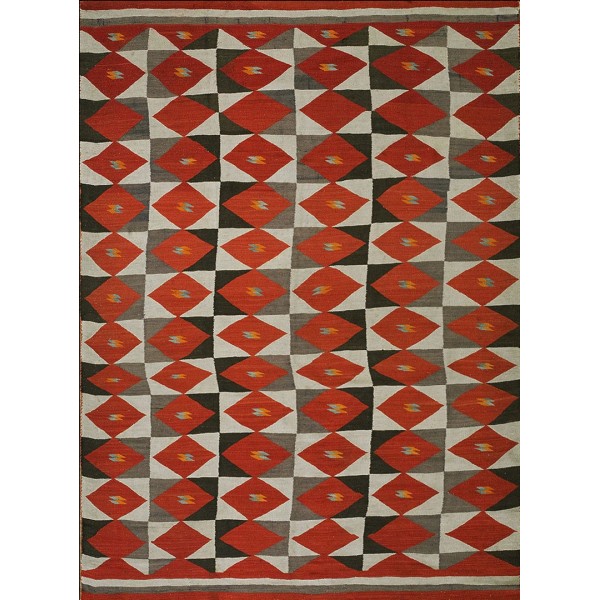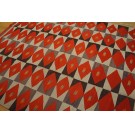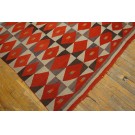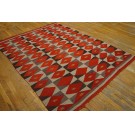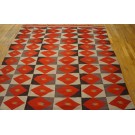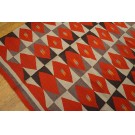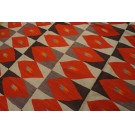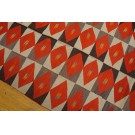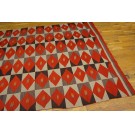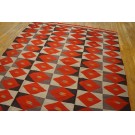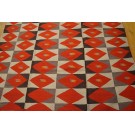19th Century American Navajo Transitional Period - Beeldlei Carpet
This piece clearly shows the transition between blankets and rugs. The blankets, woven up until the early 20th century, show, as here, no lateral borders, and a lighter, wearable handle. This piece lacks the borders, but has the heavier texture associated with floor rugs. The transition is not complete as the warp is still wool as opposed to the later machine spun cotton string found even on the best modern Navajo weavings made as wall hangings. The narrow stripes across the ends are consistent with a c. 1900, or even slightly earlier dating.
The dark chocolate brown and ecru-beige are undyed sheep wool (the churro sheep) whereas the red, carrot orange and green are locally dyed synthetics. The dyes are properly behaved, with no running or fading.
The pattern of six columns of rectangles enclosing lozenges is slightly irregular, with only single brown triangles in certain panels and some rows skipping central details in favor of solid reds. The execution is informal with panels tilting and stretching, red lozenges flattening or pulled. It may be the work of two weavers. The weavers probably spun and dyed all the wool. It was woven, as Navajo rugs generally are, on a vertical loom with a wooden framework. It is slightly larger than usual.
The pattern is unusual and lacks the zing-zags, crosses, swastikas or large lozengoid repeating medallions.
The condition is fairly good, but the ends need to be stabilized and there is one small hole. A good stretch will not hurt.
Warp: undyed ecru wool, hand-spun, 8 warps per inch;
Weft: wool, natural undyed and synthetically dyed, hand-spun; 16 wefts per inch
Technique: shared warp tapestry weave and weft-faced plain-weave
The dark chocolate brown and ecru-beige are undyed sheep wool (the churro sheep) whereas the red, carrot orange and green are locally dyed synthetics. The dyes are properly behaved, with no running or fading.
The pattern of six columns of rectangles enclosing lozenges is slightly irregular, with only single brown triangles in certain panels and some rows skipping central details in favor of solid reds. The execution is informal with panels tilting and stretching, red lozenges flattening or pulled. It may be the work of two weavers. The weavers probably spun and dyed all the wool. It was woven, as Navajo rugs generally are, on a vertical loom with a wooden framework. It is slightly larger than usual.
The pattern is unusual and lacks the zing-zags, crosses, swastikas or large lozengoid repeating medallions.
The condition is fairly good, but the ends need to be stabilized and there is one small hole. A good stretch will not hurt.
Warp: undyed ecru wool, hand-spun, 8 warps per inch;
Weft: wool, natural undyed and synthetically dyed, hand-spun; 16 wefts per inch
Technique: shared warp tapestry weave and weft-faced plain-weave
| Stock ID: | #21182 |
| General Rug Type: | North & South American |
| Specific Rug Type: | Navajo |
| Circa: | 1900 |
| Ground Color: | Red |
| Border Color: | Grey |
| Origin: | USA |
| Material: | Wool |
| Weave: | Flat Weave |
| Shape: | Square |
| Width: | 5' 6" ( 168 cm ) |
| Length: | 7' 3" ( 221 cm ) |
| Tearsheet Download |
